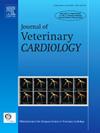Comparative transcatheter intervention for pulmonary valve stenosis: multicenter collaborative study across pediatric and veterinary cardiology centers
IF 1.3
2区 农林科学
Q2 VETERINARY SCIENCES
引用次数: 0
Abstract
Introduction/objectives
Transcatheter therapeutics have revolutionized treatment of pulmonary valve stenosis (PS). Further understanding of PS intervention may help improve outcomes for different species. This study describes characteristics and immediate outcomes in children and dogs undergoing balloon pulmonary valvuloplasty (BPV) or transpulmonary stent implantation for congenital PS.
Animals, materials, and methods
Multicenter, retrospective review from 2 pediatric and 3 veterinary centers. Demographics, procedural characteristics, and outcomes were assessed. Successful intervention was defined as a 50% reduction in transvalvar pulmonary pressure gradient (PG) within 24 h or final invasive transpulmonary gradient <40 mmHg.
Results
Data (78 children; 165 dogs) from July 2019 to June 2021 were included with BPV performed in 77 children and 145 dogs, and stent implantation in one child and 20 dogs. Stenosis was valvar in 64 children (82%) and 141 dogs (86%; P=0.50). Mean (SD) initial echocardiographic peak PG was higher in dogs [122 mmHg (39) vs. 70 mmHg (22)]. More dogs received beta-blockade at intervention (92% vs. 3%). Congestive heart failure was evident in 14% of dogs but no children. Pulmonary valve annulus diameter and balloon:annulus ratio were smaller in children 8.7 mm (3.4); 1.19 (0.3) vs. dogs 12.6 mm (4.2); 1.28 (0.24). Successful transcatheter intervention was achieved in 84% of dogs and 96% of children (P=0.008).
Conclusions
Valvar PS occurs in both children and dogs, although lesions might not be completely comparable. Preprocedural PG is higher and beta-blockers are more commonly prescribed in dogs. Successful transpulmonary intervention can be achieved in most pediatric and canine patients.
比较经导管介入治疗肺动脉瓣狭窄:儿科和兽医心脏病学中心的多中心合作研究
导论/目的导管治疗已经彻底改变了肺动脉瓣狭窄(PS)的治疗方法。进一步了解PS干预可能有助于改善不同物种的结果。本研究描述了接受球囊肺瓣膜成形术(BPV)或经肺支架植入术治疗先天性ps的儿童和狗的特点和直接结果。动物、材料和方法:来自2个儿科中心和3个兽医中心的多中心回顾性研究。评估了人口统计学、程序特征和结果。干预成功的定义是24小时内经瓣肺压梯度(PG)降低50%或最终有创经肺压梯度降低40mmhg。数据(78例儿童;纳入2019年7月至2021年6月期间的165只狗,对77名儿童和145只狗进行了BPV,并对1名儿童和20只狗进行了支架植入。儿童64例(82%),狗141例(86%);P = 0.50)。狗的平均(SD)初始超声心动图峰值PG更高[122 mmHg (39) vs. 70 mmHg(22)]。更多的狗在干预时接受β -阻断剂(92%对3%)。14%的狗有明显的充血性心力衰竭,但儿童没有。儿童肺动脉瓣环径和球囊环径比较小,分别为8.7 mm和3.4 mm;1.19 (0.3) vs.狗12.6 mm (4.2);1.28(0.24)。84%的狗和96%的儿童经导管干预成功(P=0.008)。结论患儿和犬均可发生瓣膜病,尽管病变可能不完全相同。手术前PG较高,在狗中更常用β受体阻滞剂。成功的经肺介入治疗可以在大多数儿科和犬类患者中实现。
本文章由计算机程序翻译,如有差异,请以英文原文为准。
求助全文
约1分钟内获得全文
求助全文
来源期刊

Journal of Veterinary Cardiology
VETERINARY SCIENCES-
CiteScore
2.50
自引率
25.00%
发文量
66
审稿时长
154 days
期刊介绍:
The mission of the Journal of Veterinary Cardiology is to publish peer-reviewed reports of the highest quality that promote greater understanding of cardiovascular disease, and enhance the health and well being of animals and humans. The Journal of Veterinary Cardiology publishes original contributions involving research and clinical practice that include prospective and retrospective studies, clinical trials, epidemiology, observational studies, and advances in applied and basic research.
The Journal invites submission of original manuscripts. Specific content areas of interest include heart failure, arrhythmias, congenital heart disease, cardiovascular medicine, surgery, hypertension, health outcomes research, diagnostic imaging, interventional techniques, genetics, molecular cardiology, and cardiovascular pathology, pharmacology, and toxicology.
 求助内容:
求助内容: 应助结果提醒方式:
应助结果提醒方式:


